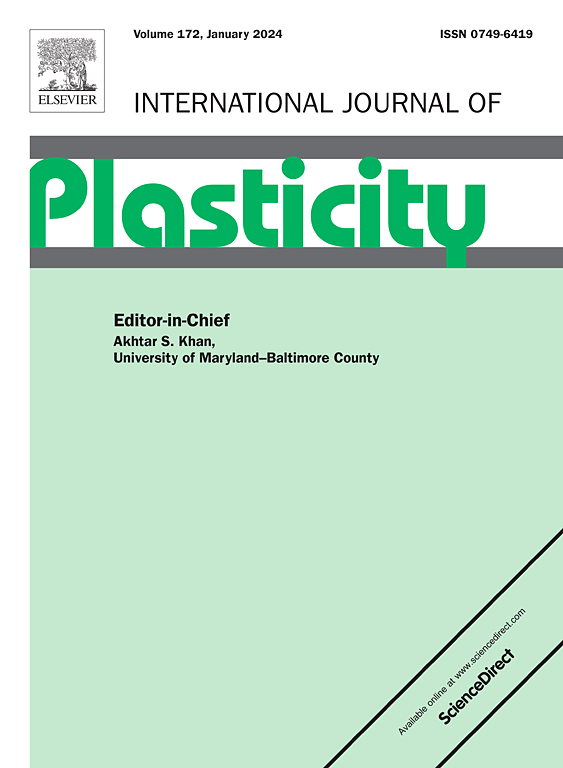6061-T6铝合金的高应变速率包辛格响应
IF 12.8
1区 材料科学
Q1 ENGINEERING, MECHANICAL
引用次数: 0
摘要
本研究旨在探讨6061-T6铝合金在不同加载速率和预应变下的包辛格效应。在应变速率为800 s-1,预应变范围为1% ~ 9%的条件下,采用改进的电磁霍普金森杆系统(ESHB)进行压缩拉伸实验。采用高速摄影和数字图像相关(DIC)技术测量应变。实验结果表明,在准静态加载下,随着预应变的增加,BE参数逐渐增强,直至达到3%,此时BE参数逐渐达到饱和。动载荷作用下,在2%预应变前,BE参数迅速上升,随着预应变的增加,BE参数持续下降。通过显微组织分析,研究了准静态加载和动态加载对BE的影响。动加载下的非单调背应力是由低预应变下动态应变时效(DSA)增强的溶质钉钉与高预应变下不可逆位错切削相的竞争引起的。抑制的热激活通过抑制交叉滑移/爬升来稳定这些亚结构。在此基础上,提出了应变率相关的Armstrong-Frederick (SAF)模型和基于物理的PB模型。与传统的Johnson-Cook (JC)模型相比,这两种模型可以更准确地描述材料在动态循环载荷下的行为,为材料性能优化和工程应用提供了有效的工具。本文章由计算机程序翻译,如有差异,请以英文原文为准。
High strain rate Bauschinger response of 6061-T6 Aluminum alloy
This research aims to explore the Bauschinger effect (BE) of 6061-T6 aluminum alloy under different loading rates and pre-strains. Compression-tension experiments were conducted using a modified electromagnetic Hopkinson bar system (ESHB) within the strain rate of 800 s-1 and pre-strain range of 1 %-9 %. High-speed photography and Digital Image Correlation (DIC) technology were employed to measure the strain. The experimental results show that under quasi-static loading, the BE intensifies with the increase of pre-strain until reaches 3 %, at which the BE parameter reaches saturation gradually. Under dynamic loading, the BE parameter goes up rapidly before 2 % pre-strain and then reduces continuously as pre-strain increases. Difference in the BE between quasi-static and dynamic loading were investigated by microstructural analysis. The non-monotonic back stress under dynamic loading arises from competition between dynamic strain aging (DSA) enhanced solute pinning at low pre-strains and irreversible dislocation cutting of precipitates at high pre-strains. The suppressed thermal activation stabilizes these substructures through inhibited cross-slip/climb. Based on the experimental results, a strain-rate dependent Armstrong-Frederick (SAF) model and a physical-based (PB) model are proposed. Compared with the traditional Johnson-Cook (JC) model, these two models can describe more accurately the behavior of the material under dynamic cyclic loading, providing effective tools for material performance optimization and engineering applications.
求助全文
通过发布文献求助,成功后即可免费获取论文全文。
去求助
来源期刊

International Journal of Plasticity
工程技术-材料科学:综合
CiteScore
15.30
自引率
26.50%
发文量
256
审稿时长
46 days
期刊介绍:
International Journal of Plasticity aims to present original research encompassing all facets of plastic deformation, damage, and fracture behavior in both isotropic and anisotropic solids. This includes exploring the thermodynamics of plasticity and fracture, continuum theory, and macroscopic as well as microscopic phenomena.
Topics of interest span the plastic behavior of single crystals and polycrystalline metals, ceramics, rocks, soils, composites, nanocrystalline and microelectronics materials, shape memory alloys, ferroelectric ceramics, thin films, and polymers. Additionally, the journal covers plasticity aspects of failure and fracture mechanics. Contributions involving significant experimental, numerical, or theoretical advancements that enhance the understanding of the plastic behavior of solids are particularly valued. Papers addressing the modeling of finite nonlinear elastic deformation, bearing similarities to the modeling of plastic deformation, are also welcomed.
 求助内容:
求助内容: 应助结果提醒方式:
应助结果提醒方式:


